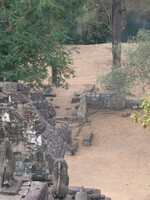| dc.coverage.spatial | Site: Bakong (Phumĭ Rôluŏs Chăs, Siĕm Réab, Cambodia) | en_US |
| dc.coverage.temporal | dedicated 881 (creation) | en_US |
| dc.creator | unknown (Cambodian) | en_US |
| dc.date | 850-881 | en_US |
| dc.date.accessioned | 2013-12-19T17:02:54Z | |
| dc.date.available | 2013-12-19T17:02:54Z | |
| dc.date.issued | 850-881 | en_US |
| dc.identifier | 242108 | en_US |
| dc.identifier.other | archrefid: 2752 | en_US |
| dc.identifier.uri | http://hdl.handle.net/1721.3/150397 | |
| dc.description | Pathway between enclosure all on the right and the tower area, with pergola arching overhead; Roluos is a modern Cambodian small town and an archeological site about 13 km east of Siem Reap. Once the seat of Hariharalaya, the first capital of the Khmer Empire north of Tonlé Sap. Among the "Rolous Group" of temples is the most impressive, the Bakong complex, whose central pyramid stands 14 meters tall. Constructed by the third Angkorian-era king Indravarman I as his state-temple (to house the royal liṅga Indreshvara), Bakong represents the first reasonably complete temple-mountain architectural formula on a grand scale and set the architectural tone for the next 400 years. The temple displays a very early use of stone rather than brick (brick was used in the 22 smaller satellite tower-sanctuaries between the two moats.) Bakong received additions and was expanded by later kings. The uppermost section and tower were added in the 12th century. Source: Grove Art Online; http://www.oxfordartonline.com/ (accessed 4/29/2013) | en_US |
| dc.format.medium | sandstone; laterite; brick | en_US |
| dc.rights | © Scott Gilchrist, Archivision, Inc. | en_US |
| dc.subject | architecture | en_US |
| dc.subject | rulers and leaders | en_US |
| dc.subject | Hinduism | en_US |
| dc.subject | Shiva | en_US |
| dc.subject | linga | en_US |
| dc.subject | lingam | en_US |
| dc.subject | devarāja cult | en_US |
| dc.subject | Angkorean | en_US |
| dc.title | Bakong [site] | en_US |
| dc.type | image | en_US |
| dc.rights.access | Licensed for educational and research use by the MIT community only | en_US |
| dc.identifier.vendorcode | 1A2-CB-BA-A39 | en_US |
| vra.culturalContext | Cambodian | en_US |
| vra.technique | carving (processes), construction (assembling) | en_US |
| vra.worktype | historic site | en_US |
| vra.worktype | temple | en_US |
| vra.worktype | excavation (site) | en_US |
| dc.contributor.display | unknown (Cambodian) | en_US |


